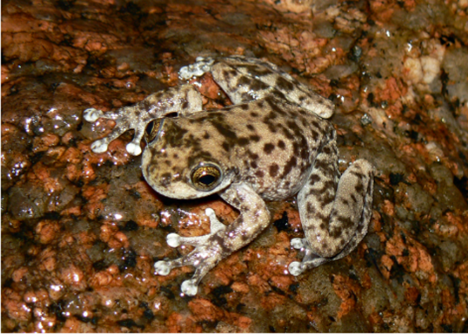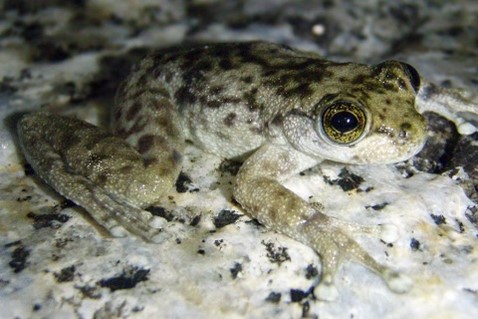Armoured mistfrog

Common name: armoured mistfrog
Scientific name: Litoria lorica
Family: Hylidae (tree frogs)
Conservation status: Critically endangered
The armoured mistfrog is a small tree frog that lives around waterfalls and cascades for its entire life cycle. The frog has adapted big finger and toe pads that help it grip to the wet rocks. The males (average 32mm) are slightly smaller than females (average 35mm) and have black, spiny pads on their thumbs and chest, for gripping females during mating. The armoured mistfrog camouflages well into its environment - with big, beautiful blotches on its upper surface that look like the granite boulders it resides on.
Unfortunately, the armoured mistfrog is considered one of the top five Australian frog species most likely to go extinct in the next one to two decades due to its small population size and human impacts.
The armoured mistfrog is endemic to the Wet Tropics of northern Queensland. Previously found in five rainforest areas, the population crashed in the early 1990s due to amphibian chytrid fungus disease. It was considered extinct for about 14 years until the rediscovery of a single small subpopulation in 2008 in the Mount Carbine Tablelands.

Threats and recovery actions
The subpopulation has been able to live with the chytrid disease by moving from its usual cooler wet habitat, where the disease thrives, to a warmer drier environment. The habitat consists of permanent streams flowing over exposed granite rock with many complex cascades and waterfalls, in open woodland. The open, rocky environment offers ideal foraging and breeding habitat.
The small population size makes the species more vulnerable to random environmental events such as disease outbreaks, droughts and floods. Other threats include human disturbance which may stress the frogs, increase the risk of introducing diseases and impact water quality and habitat.
Thanks to conservation efforts, a second small subpopulation has been established approximately 4km upstream from the main subpopulation. The 2013-2015 reintroduction program involved the Department of Environment and Science partnering with James Cook University and Western Yalanji Aboriginal Corporation.
A third subpopulation is being established in another catchment in the Wet Tropics. This project is a collaboration involving the Department of Environment, Science and Innovation, James Cook University and Western Yalanji Aboriginal Corporation. This project is partly funded by the Foundation for Australia’s Most Endangered Species (FAME).
Fifty frogs were successfully translocated to the new site in 2023 with another 50 to be translocated in 2024. This third subpopulation is vital for reducing the risk of the species becoming extinct.
James Cook University is monitoring all three sites for three years to determine translocation success and the need for further reintroductions.
The department is also investigating approaches to minimise human impacts on the main subpopulation and developing a Recovery Action Plan that identifies the management actions to help the species recover.
For more information about the armoured mistfrog, view the species profile.
Learn more about how you can help the armoured mistfrog and other Australian wildlife by supporting threatened species projects and caring for our native plants and animals.


